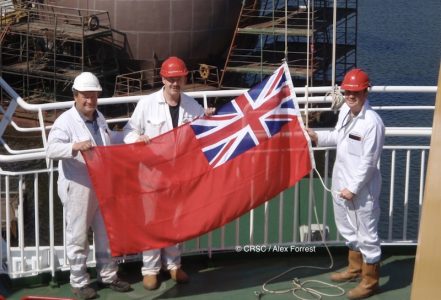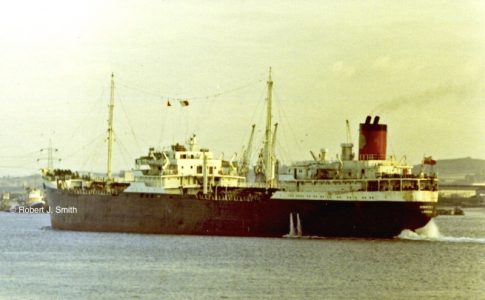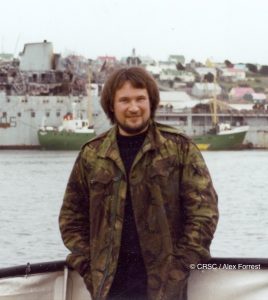
Demob happy: Alex Forrest (left) on Clansman with Captain Norrie MacDonald at Oban on 12 December 2018, his last day as a CalMac employee
At 30 years of age Alex Forrest became Chief Engineer of a 30,000-ton tanker on the Pacific Ocean. Now 64, he has just retired after 28 years with CalMac — but, as he explains to CRSC’s Andrew Clark, he is not yet ready to give up a life at sea.
Mechanically speaking, says Alex Forrest, the pinnacle of a Chief Engineer’s career has to be a crankcase explosion. Some engineers never experience it, but Alex’s ‘pinnacle’ came in March 2017 on Finlaggan, CalMac’s Islay ferry: the starboard main engine lubricating pump overheated and the oil exploded. “It was a mess,” he recalls, “but I enjoyed the challenge of finding the cause and getting it repaired. I came to CalMac from the tanker industry, where things are always breaking. Some ships have more breakages than others, but if things never break, you never learn anything.”
That reaction just about sums up Alex Forrest — never happier than when he has some mechanical problem to solve. His ‘go-to’ professionalism, allied to natural good humour, has reassured many a crisis-stricken master over the years. Whenever anything goes wrong on a ship, it is the chief engineer’s job to get it fixed, whether it’s a broken winch, faulty heating, malfunctioning catering equipment — or a crankshaft explosion.
The explosion on Finlaggan happened at Port Ellen, shortly after the vessel had emerged from annual overhaul. Alex and his colleagues had not only to make the necessary repairs, but also to check whether the explosion had damaged the main engine bearings: fortunately they were unaffected.
The Maritime and Coastguard Agency gave special permission for the vessel to sail on one engine without passengers as far as Kennacraig, where repairs were carried out and Lloyds of London undertook a survey. Finlaggan was off the run for just two days.
Alex’s calm in the midst of a crisis may be partly due to his ‘glass half full’ attitude to life, but it also stems from vast experience — deep-sea, where he began working on steam turbine tankers in the early 1970s, and on the west of Scotland, where since 1990 he has served on every CalMac major unit except Loch Seaforth.
He has forthright opinions on them all. Finlaggan and Clansman are established favourites, as much for their “friendly” crew as for their mechanical performance.
Surprisingly, Coruisk also gets the thumbs-up — in stark contrast to Loch Nevis, which “just didn’t appeal to me”. Lord of the Isles is “a heap of scrap”, while Isle of Arran and Hebridean Isles have “done their time”.
Affectionately known throughout the fleet as ‘Wee Chief’, Alex has always conveyed the impression that he enjoys his job. So why did he retire? Pause for thought. “It got to the stage — do I carry on, or do I call it a day? All of a sudden, I thought ‘it’s time to retire’.”
Retirement from a pensionable job, yes, but not from marine engineering. Alex has already signed up for agency work, and there are hopes he will continue volunteering on Maid of the Loch and Waverley, on whose engine platforms he has served in dungarees in recent years.
Brought up in Coatbridge, Alex blames his love of engines on the ‘Maids’, the quartet of diesel passenger vessels that regularly took him as a child to and from Millport, where his parents had a holiday house and he was always messing about in boats. “On the ‘Maids’ you could look down and see the engineer at the controls,” he says. “That’s what made me want to be a marine engineer. Talisman was my favourite boat — seeing the big electric motor.”
In 1972, aged 17, Alex applied to Shell to be an engineering cadet and began a four-year course at Glasgow Nautical College, which included a year at sea. His first ship was Opalia, a 1960s crude oil tanker, which he joined near Marseille and stayed with for four and a half months.
His second ship was Hinnites, running between Singapore and Saigon (now Ho Chi Minh City) with jet fuel for the American war effort in Vietnam. Having finished his cadetship in September 1976, he became Fifth Engineer on Anadara, followed by two other steamships.
It was then that he realised he needed motor ship experience — and to get that, he needed to leave Shell.
He joined Canadian Pacific in 1977, started again as Fifth Engineer (at New Orleans, on the diesel-engined bulk carrier W M Neal) and never looked back. “I have always liked motor ships — there’s more engineering going on,” he says. “On the steam tankers you never touched the turbines, but with the motor ships you get the chance to go inside the crank cases and also overhaul the valves.”
The end of the Falklands War (1982) found him as Second Engineer on a tanker anchored off the airport at Port Stanley, pumping 100,000 gallons of jet fuel ashore every day. In November 1983 he returned to college to study for his Class One (Motor) certificate, and passed at first attempt in March 1984. He was now qualified to be Chief Engineer.
Alex says the two scariest things you do as an engineer are first, joining a ship for your very first trip, and second, being promoted to the rank of Chief.
His own elevation came sooner than expected. Immediately after gaining his Chief’s ticket, he re-joined Fort MacLeod, a 30,000-ton product tanker, as Second Engineer. “We had just come out of Los Angeles, heading for Panama, when the Chief’s wife took seriously ill and they both had to go off the ship. There was only one way the ship could sail, and that was with me as Chief. I was 30 when I took responsibility for a tanker.”
After marrying Susan in 1985, Alex began looking for a home-based job. He wrote to CalMac and, after a long wait, was called to Gourock for interview by Davie Spence, Engineering Superintendent (Clyde). That led, in 1990, to a job as Second Engineer on Isle of Arran — arguably a come-down for a Class One engineer with experience of the 50,000hp T G Shaughnessy.
That supertanker’s generators were bigger than the main engines on CalMac ferries. And yes, Alex was better qualified than many of his CalMac peers, because at that time you only needed a Second’s ticket to qualify for a Chief Engineer’s job on a coastal ship up to 6,000hp.
For Alex, the challenge of working on a coastal ferry lay not so much in getting used to smaller engines, as looking after what he calls “the hotel services equipment” — dishwashers, ice-making machines, passenger lifts. He also had to get used to maintaining the bow visor and stern ramp. “As well as being an engineer, you are Mr Fixit”, a job for which he has always won plaudits.
It wasn’t long before he won promotion to Chief Engineer on the ‘streakers’ and Pioneer (Mirlees Blackstone engines, “very simple and basic machinery”), but this only made him yearn for a job on the bigger ferries. After 18 months he made his case to Jack Anderson, CalMac’s Engineering Superintendent for the Western Isles, and moved to Isle of Mull as Second Engineer.

Alex (left) as Chief Engineer of Isle of Mull at Lochmaddy in 1998, with longtime MacBrayne bus and lorry driver Alasdair MacCorquodale (centre) and Captain Ian Dewar
She was still relatively new at the time, with much the same mechanical setup as Hebridean Isles and Isle of Arran (same turbochargers, fuel pumps and 2,300hp Mirlees engines).
But there was one significant difference: “Isle of Mull has shaft alternators, so when you start up the bow thrust, it limits the power going to the main propellers to 1,700hp. Isle of Arran and Hebridean Isles have separate diesel bow thrusters. The ‘Mull’ struggles for power, especially in the confines of Oban Bay, where her ‘block of flats’ observation lounge catches the wind at the stern.”
Working on the ‘Mull’ nevertheless confirmed his preference for life on the Hebridean ferries — “they’re bigger boats, with a greater variety of runs. The Clyde is more of a bus service.”
After six months on the Craignure run Alex was promoted to Relief Chief — a chance to get to know the entire fleet. Around this time (1995/6) the CalMac rota system for senior officers changed from two weeks on/two weeks off, with the obligation to apply for holiday leave, to the present system of two-on/two-off/two-on/four-off, inclusive of holiday leave.

Alex (far right, in white overalls) with the crew of Clansman c2009, with Captain Guy Robertson third from right
“So from that time, when a permanent Chief got his four weeks off, he needed a relieving Chief. That was when they paired me up with Lord of the Isles and Isle of Mull.”
When Clansman came out in 1998, Alex worked alternately on the ‘Mull’ and the new vessel — the first in the fleet with MAK engines, and the first with a shaft alternator that could supply power not just for the bow thrust but for the ship’s entire electrical needs, meaning the diesel generators could be switched off during the day.
It was new technology — and a different mechanical concept. One quirk of the system was that, “if the main engine stopped unexpectedly, you lost electrical power until the diesel generator started up automatically and you got electrical power again.”
A related problem was that, in heavy weather, if the ship was rolling badly and the propeller was lifting in and out of the water, the main engine governor could not react quickly enough to the sudden changes of speed.
“So you found the electrical frequency dropping to 48 or rising to 52, which is not good for the ship’s electrical supply. In those conditions, you need to switch from the shaft alternator to the diesel generator alternator in order to stabilise the supply. This can be difficult, because the frequency of the two alternators has to be an exact match in order to transfer the load from one to the other. Eventually everybody got used to it and now it’s second nature. In heavy weather, the practice now is to leave the diesel generator on.”
When Hebrides came out in 2001, Alex’s ‘pairing’ became Clansman and the new ship — “just about sister ships”, though his preference has always been for Clansman, whose crew he found “a particularly friendly group”.

On Finlaggan at Gdansk in 2011 with Captain Guy Robertson (centre) and Chief Officer (now Captain) John Archie Campbell (right)
This was the period when he became firm friends with Guy Robertson, who had been Second Mate on Isle of Mull and now came to Clansman as Chief Officer. When Guy was promoted to master, they found themselves on similar shifts on Clansman. “We worked well together.”
Alex then transferred for two years to Lord of the Isles, which has the same make of engines as the ‘Mull’ and the ‘Arran’, but with several significant differences. ‘LOTI’, he says, has bigger fuel pumps, bigger turbochargers and bigger injectors, and the engines run 100 revs per minute faster than the others. “That means more power — 2,900hp compared to 2,300, so she goes faster.”
Nevertheless, Alex makes no secret of his view that ‘LOTI’, like some other older ferries, has been kept on too long for the sort of workhorse role she is expected to fulfil, making her increasingly costly to maintain, because many of the parts are now obsolete.
In 2010 he and Captain Robertson were invited to stand by Finlaggan during the final phases of construction by Rementowa at Gdansk. “We saw her come to life [between January and May 2011] and brought her home” — a process he describes as “a steep learning curve for everyone.” He had already been to Finland for a short course of familiarisation with her Wärtsilä engines, which he describes as “better than Mirlees but not as good as MAKs. There are too many awkward wee bits on them, and they are expensive to maintain: the spare parts cost more than MAKs. But Finlaggan is a good boat. She has a deeper draught than the others — 3.4 metres compared to 3.2 — which enables her to carry a heavier commercial cargo than most ferries of her length. Internally she is nicely finished, comfortable for crew as well as passengers. There are 34 single crew cabins, all with their own shower and toilet. That was a first in the fleet.”

Alex in the control room of Clansman’s engine room on his last day as a CalMac employee, with 3rd Engineer Stuart Dunn (left) and motorman Angus Steele (right)
Alex says Finlaggan’s deeper draught has proved useful on the Islay run, which sees a lot of heavy vehicle traffic, “but she’s shorter [than Clansman and Hebrides]. If she had been any longer, she would have difficulty turning at Port Ellen, and at Port Askaig she would stick out too much into the tide. That’s why Clansman and Hebrides don’t do that run. The bow would be right out [in the Sound of Islay] and you wouldn’t be able to hold it against the tide — unless you were to put in a new dolphin or move the linkspan back.”
After three years on ‘Super Fin’ Alex was transferred to a relieving slot, which gave him the opportunity to refresh his knowledge of the fleet. The only vessel that disappointed was Loch Nevis, and he can’t quite pin down why. “For some reason she just didn’t appeal to me. The engineer is up on the bridge all the time because that’s where the control room is, but it’s the same on Coruisk and I thought she was a great wee boat — Alan the cook was brilliant! She is extremely handy — she can do Armadale, Mull and Rothesay, all with a crew of nine.”
Coruisk also scores highly in the engineering department: “She’s nice and simple and doesn’t use a lot of fuel. Clansman uses 1,200 litres an hour at 16½ knots. Coruisk uses only 4,000 a day on the Mull run, at about 12½ knots.”
If Alex’s level-headedness will be missed on board, so will his skills as a union representative on land: for eight years he served as engineering liaison officer in negotiations between the politically unaffiliated Nautilus union and CalMac management. He says the job gave him the chance to “make a real difference to colleagues’ working conditions.” Any tips for his successors in that department? “Never get riled. Get [the opposing side] to lose the plot and you’ve won. We did it a few times. There were occasions when we closed the folders and threatened a ballot of our members. With a high Nautilus membership among CalMac officers, we always had strong union support.”
It has given Alex great satisfaction in recent years to see his two children, now in their 20s, pursuing careers at sea, much like he did at the same age. His geographical horizons may have narrowed a little over the course of a distinguished life at sea, but it is good to know his ‘Mr Fixit’ skills will still be available in semi-retirement, and that — aboard his own impeccably maintained boat, Spirit of Cumbrae, if not a CalMac ferry — he will remain a kenspeckle figure throughout the Clyde and Western Isles.

‘Crossing the line’ ceremony at the Equator in 1982, with Alex standing left of centre with beard and blue hat
Not yet a member of CRSC? Join for £10 and get all the benefits by clicking here.






















